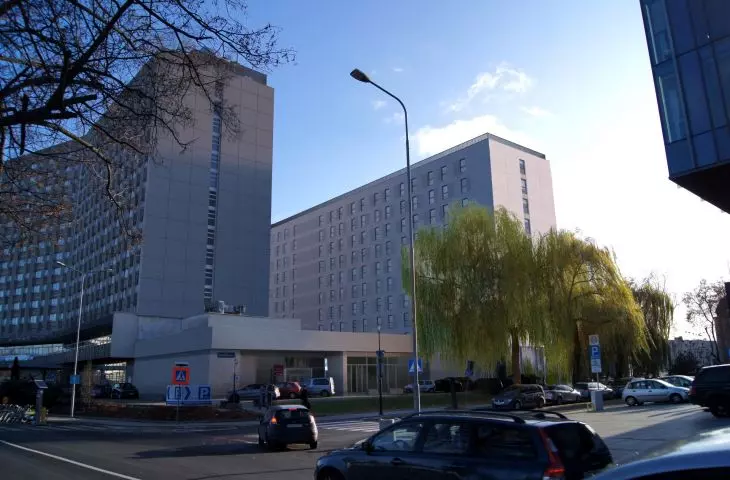It was Poland's first high-end hotel made of large slabs. After half a century of existence, it will have a new wing maintained in the spirit of the original. The former Hotel Polonez, now a private student house, is being expanded in the center of Poznań. The site is spatially and symbolically important, but there is no development plan for it.
At the dawn of the 1970s, Poznań had far too few hotel spaces to accommodate the numerous visitors to the Poznań International Fair. True, in 1964 a large, modern and successful Hotel Merkury (now Mercure) was built right next to the Fair, but this establishment, then owned by Orbis, did not solve the accommodation problem. Therefore, in 1972, a decision was made to build a new Orbis hotel "Polonez" for 612 people, in a more secluded location - at Niepodległości Avenue (then Stalingradzka) near the Citadel Park and the Old Town.
The building was erected at the foot of St. Adalbert's Hill, right next to the Cemetery of Merit of Greater Poland. In order to speed up construction, it was decided to build from the so-called "big plate", using slightly modified prefabricated elements used for erecting blocks of flats in the Winogrady district (see construction photo). It was emphasized that this was the first "high category" hotel in Poland made using this technology. Construction took two years and was completed in May 1974. The main authors of the project were Poznan architects from Inwestprojekt: Józef Maciejewski, Jerzy Liśniewicz, Stefan Zieleźkiewicz and Janusz Lenartowicz (interiors).
Student Depot Polonez dormitory in Poznań - view from the west from al. Niepodległości, front and gable elevations
photo: Jakub Głaz
dominant behind the villas
Measuring fourteen stories and fifty-five meters in height, the hotel rising from an expansive low "footing" has become a significant, if somewhat haphazard, dominant feature at the northern end of Niepodległości Avenue delineated in the early 20th century along the outer perimeter of demolished 19th-century fortifications (part of the so-called Stuebben ring). Planted with rows of trees, the avenue with a strolling path in the middle led from the center toward the green slopes of the Citadel and had a representative character from the very beginning.
In the inner city, the Germans enclosed it with new important buildings, led by the Imperial Castle (1910, designed by Franz Schwechten). In the interwar period, Poles maintained this monumental scale, erecting, among others, the building of today's University of Economics and a sizable student house (1929, designed by Roger Slawski; today DS "Hanka"). Instead, magnificent villas were built closer to the Citadel. Polonez "shot up" rather unexpectedly to the north of them.
Student Depot Polonez dormitory in Poznań - view of the dormitory from the south, from Kulas Street; the new wing will overshadow the building from this side in front of the building; a mural dedicated to Jan Kulczyk can be seen on the gable wall
photo: Jakub Głaz
they did not demolish
Thehigh standard of the hotel was visible primarily in the interiors, especially in the lobby, café, restaurant and banquet hall. From the outside, the building is still characterized by good proportions (thanks to the shallow tracts, the building is slender) and , by breaking the mass , lightness and good seating by the arched avenue. However, the facades, made of large slabs, did not match the beauty and quality of either the Mercury, which was ten years older, or the Provincial Office, built a few years earlier on the same avenue (1968, designed by Jerzy Buszkiewicz and his team).
The high category of the Polonez declined over time, until the arrival was closed in 2012. At the time, plans were made to demolish it. However, intentions changed and - after Orbis sold it - the building was transformed (according to a design by the Poznan-based Matyja and Ritter studio) into a private dormitory belonging to the Student Depot chain. The changes took place mainly inside, from the outside the building was not modified.
Student Depot Polonez dormitory in Poznan - view from the cemetery of the Deserved of Greater Poland, the new wing will be built on the left and will cover the view of the Marshal's Office
photo: Jakub Głaz
The location in the center, opposite the UAM Faculty of Law, built in 2010 (designed by Pracownia Architektoniczna 1997), is very attractive, so already a few years ago the owner attempted to build another dormitory - next door, on the site of a demolished two-story hotel parking lot. The Office of the City Historic Preservationist had a lot to say here, as the building was to stand close to the scenic axis on St. Adalbert's Hill. However, the project negotiated with the preservationists (also by Matyja and Ritter) was abandoned, and the developer sold the land after the parking lot (it's still empty today).
Acomeback of the big board?
Now the expansion is starting at the back, on the south side of the Polonez, on the site after the "foot" of the building that housed, among other things, offices, a restaurant and a banquet hall (it housed a private school until last year). "The foot" has just been demolished, ground piling will soon begin, and by next fall a ten-story straight wing with modest elevations reminiscent of the former hotel is expected to rise. It will have space for 408 tenants. The new building will be located right next to the Cemetery of Merit of Greater Poland, from which it will be separated by a pedestrian and bicycle lane of Piotr Majchrzak. At the same time, it will obscure the view of the greenery and the hill from some of the rooms of the existing building.
Student Depot Polonez dormitory in Poznań - the site of the demolished "footer" of the former hotel housing a restaurant and services (most recently: a private school)
photo: Jakub Glaz
Will it - like the Polonez - be made of prefabricated elements returning to favor? Piotr Stronka, investment manager with Student Depot reports:
We plan to use traditional methods, although the company is still considering using large-scale prefabricated elements similar to those used during the construction of the Polonez.
Stronka adds that the long-planned thermal modernization of the southern and northern elev ations will take place during the expansion . The gable walls have already been insulated. One of them features a discreet, almost imperceptible mural commemorating Jan Kulczyk.
Student Depot Polonez dormitory in Poznań - expansion - view of the new wing from the southwest from Kulas Street, on the left a fragment of the Marshal's Office, between the Office and the new wing - a fragment of Polonez, visualization
© Matyja and Ritter
borrowed height
The building permit for the new wing was issued on the basis of development conditions, because there is still no local zoning plan for the area around Independence Avenue and the historic St. Adalbert Hill (it hasn't even been called). Thanks to this omission, in the past two decades Polonez has already served as a reference point twice for the construction of tall buildings in the neighborhood: first in 2008 - a residential complex on Kutrzeby Street, and seven years later - the new headquarters of the Marshal's Office.
Residential complex on Kutrzeby Street between the dormitory and Citadel Park
photo: Jakub Głaz
The design of the latter was selected in a 2009 competition (designed by Krzysztof Kozlowski, Warsztat Architektury Pracownia Autorska). From Polonez the Authority "borrowed" the height, but it is much more massive and - despite the strong glazing - even "fortified" in its own way. The architectural community of Poznan, moreover, protested at the end of the noughties against such a grandiose block in this place and relying on the so-called "good neighborhood" (to build the Office, a former socialist-realist school from the 1950s was demolished).
Student Depot Polonez dormitory in Poznań - Niepodległości Avenue, in the foreground: the Marshal's Office, in the background: Polonez, the new wing will be obscured by the body of the Office
Photo: Jakub Glaz
The mass of the Marshal's Office, however, will now make the new dorm wing almost invisible from the side of Niepodległości Avenue, so the expansion will not strongly affect the appearance of the street.
Student Depot Polonez dormitory in Poznań - view from the UAM grounds, north side of Niepodległości Avenue, left: Polonez, right: Marshal's Office, the new wing will be only partially visible from here
photo: Jakub Głaz
However, it will be different on the side of the cemetery and the historic hill. Already today the Polonaise makes a strong mark in the space of Poznan's important necropolis. This effect will be stronger in the future.
Student Depot Polonez dormitory in Poznan - general view from the cemetery, the new wing will obscure the clearance between the buildings
photo: Jakub Głaz
At the same time, Polonez will also lose some lightness. Integrating the new part into the neighborhood therefore has both pros and cons. It is high time, therefore, that Niepodległości Avenue and its surroundings are finally included in the local plan, which will limit the long reign of "good neighborhoods" in this place.




























































